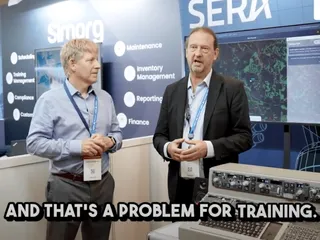Training Insights on RNoAF’s F-35A “Hotpit Refueling” Success
Contact Our Team
For more information about how Halldale can add value to your marketing and promotional campaigns or to discuss event exhibitor and sponsorship opportunities, contact our team to find out more
The Americas -
holly.foster@halldale.com
Rest of World -
jeremy@halldale.com

Manned and unmanned military aircraft landing on highways not part of a service’s base and station infrastructure is nothing new. Indeed, during the Cold War, Norway was one NATO nation that perfected their jet fighters’ ability to disperse and safely operate where they were not vulnerable. More recently, this May, during US Air Force Special Operations Command’s Exercise Agile Chariot, one MC-130J, an MQ-9 Reaper and two A-10s were the fixed-wing aircraft that completed successful highway landings in rural Wyoming. This September 21, the Royal Norwegian Air Force dramatically expanded the mission envelope of F-35As and for this task, with two of its F-35As landing on a highway in vicinity Tervo, Finland. Lt. Col Morten Hanche, Air Warfare Center/Fighter Branch, Royal Norwegian Air Force, took time from his busy duties to update MS&T on the training efforts behind the service’s recent hallmark success.
Beyond Cold War Readiness
This October 25, the senior officer first pointed out short field landings and dispersed operations were part of an established concept of operations for Norwegian F-16s, and, in part, drove the requirement for drag chute on these airframes. “However, the concept eventually died after the Cold War ended, but the idea was never really forgotten. The shift towards few bases was really driven by political decisions and economic priorities. The fact that our F-35s, too, are drag chute- equipped, and this requirement was sponsored and funded by Norway, also reflects that the Norwegian Armed Forces never completely shelved the ideas about dispersed operations,” Hanche added. As important data points, RNoAF declared initial operational capability on its F-35A fleet in 2019. Fifty-two “As” for this service are on the OEM Lockheed Martin’s order ledger.
One of two RNoAF F-35As landing on a roadstrip in Finland -- the first such "A" variant mission. Image credit: Royal Norwegian Air Force/Andreas Vekve.
An Event First
While F-35B variant aircraft have completed missions and training in forward-based locations, this was the first instance of an F-35A completing this type of task. Flexing the operational envelope, immediately after the two F-35As landed, refueling was carried out with the engines running (“hotpit refueling”). Shortly after, the “As” took off and were ready for new missions.
The Imperative for a Live/Virtual Training Mix
The service senior officer said the preparations for the Finland landing were mainly done in F-35A simulators, by practicing landings on the taxiway at Bodø airfield, which is 75ft [23m] wide. “This is a close approximation to the 65 ft wide roadstrip at Tervo. In addition to this, our F-35 pilots regularly land on the parallel runway at Ørland, which is only 100 ft wide – not that much wider than Tervo roadstrip.”
Further, build-up was also included in the plan, by deliberately executing a low approach first, then touch-and-gos prior to full stop landings at Tervo road strip. Hanche added, “This way, the pilots were primed to familiarize themselves with the unique sight pictures (trees on both sides, narrow runway, trees short of the runway, etc.) and wind-shear effects. As a final risk mitigating measure, both pilots flying were experienced both on the F-16 and F-35.”
Enter Finland, which became a NATO member earlier this year and is an important, long-standing close partner for the Norwegian Air Force. Norway continued to increase its joint training capacity with Finland through this successful landing event, with the two F-35As landing on the highway near Tervo after a training event with Finnish Air Force F/A-18Cs.
Returning to the value of simulator-enabled training, Hanche reminded MS&T that his service uses its F-35A simulators to train a wide variety of tasks, from peacetime “admin skills”, including instrument flying and handling emergencies, to training wartime scenarios. “We emphasize simulator training with adverse weather and nighttime conditions – both in order to mimic the fact that Norwegian weather frequently should be described as ‘bad,’ but also in order to ‘train hard.’ The simulators are a very valuable tool for us, especially when it comes to training advanced tactics.” Indeed, while RNoAF F-35A simulators already support several airfields which are relevant with regards to dispersed operations, Norway is also pursuing tools to enable organic F-35A simulator scenario updates, in order to also support higher fidelity training of dispersed operations.
[A video of the RNoAF F-35A mission in Finland may be viewed here. Source: Royal Norwegian Air Force. Credit: Martin Nellquist]


